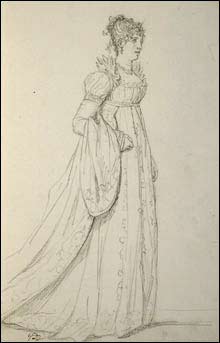
PAULINE BONAPARTE, THE PRINCESS BORGHESE: David’s studies for The Coronation of the Emperor Napoleon I point up the wealth of the Fogg’s holdings.
|
In 1946, after two years studying art at Boston’s Museum School, a 25-year-old Ellsworth Kelly returned to France, where he’d served with an Army camouflage battalion during World War II. He jotted glimpses of windows, shadows, branches, chimneys. In four pages from 1950 that are included in “Under Cover: Artists’ Sketchbooks” at Harvard’s Fogg Museum, you look over his shoulder as he studies the striped fabric and odd patches of a cabana on a French beach. If you’re familiar with his trademark striped paintings and monochrome panels, you can imagine how he’d go ga-ga for the abstraction he discovered in the fabric. He pares the pattern down to just the patches, demonstrating his method of editing bits of the world until they become disorientingly abstract while maintaining the particularity of their worldly shape.
“Under Cover” is one of those lucid, edifying shows the Harvard museums excel at. Drawing on the institution’s collection, curator Miriam Stewart has assembled 70 sketchbooks and 45 drawings orphaned from sketchbooks from the past 350 years to catalogue, beautifully and precisely, the various species: the artistic diary, the storehouse of sights recorded for future reference, the workbooks in which artists like Kelly puzzle out ideas and designs.
Sanford Robinson Gifford produces tiny precise landscape drawings while searching for fodder for paintings. A facsimile of one of his albums that you can flip through includes a pacific rendering of Harper’s Ferry in Virginia, drawn less than a year after John Brown seized the federal arsenal there and a year before the Civil War began. In 1903 and ’04, Evelyn De Morgan practices drawing hands, feet, the bend of an elbow. In the ’20s, the Reverend Sebastian Gates studies bugs, butterflies, and the downy belly of a dead lesser Antillean tanager lying on its back. He renders them delicately and photographically, as if they were pinned into an album.
The most astonishing testimony to the wealth of the Fogg’s holdings is two books of Jacques-Louis David studies for his famous 1807 painting The Coronation of the Emperor Napoleon I. Here Bonaparte’s sister stands stiffly, there a naked Napoleon holds the crown he will place on his wife Joséphine’s head. Please note that the emperor’s small wiener (talk about a Napoleon complex) does not necessarily represent his true manhood, since the body is drawn from a stand-in for the busy ruler. Again there is a facsimile you can leaf through filled with the cast of thousands in all their finery, the drawings gridded in preparation for transfer to the canvas.
At the turn of the 20th century, John Singer Sargent dashes out groups of people and dynamic gestures for his Boston Public Library murals. In the ’40s, Henry Moore and David Smith plan out sculptures in the late Cubist-Surrealist style it seemed anybody who was anybody employed before Abstract Expressionism burst onto the scene.
ADVERTISEMENT
 |
Some, like the great draftsman George Grosz, are flattered by the show’s emphasis on drawing. Others, like Cézanne and Manet, are represented by clumsy sketches that suggest their genius lay with the paintbrush, not a pen or pencil.
In the summer of 1950, the same summer young Kelly was doodling in France, a 57-year-old Grosz was down in the dumps in New York. In his native Germany, his incendiary caricatures of corrupt, incompetent politicians and generals, war profiteers, maimed veterans, prostitutes and a feral citizenry had won him artistic accolades and landed him in hot water. (Grosz’s work, so suited to our political moment, cries out for a retrospective exhibit.) He fled to Manhattan in 1933, just moments before Hitler became chancellor of Germany and the Nazis visited his Berlin home and studio hunting for him. He arrived enthusiastic to start over, but nearly 20 years later he was struggling to make ends meet. Life magazine was asking whether Jackson Pollock was “the Greatest Living Painter in the United States.” Meanwhile, in the New York that was on the cusp of supplanting Paris as the center of the artistic universe, Grosz’s old-school style wasn’t selling.
“I must have somehow or other wanted this slow form of suicide,” he wrote to a friend. “ . . . But no one (apart from alcohol) can help a person in this position. Believe me, behind my LAUGHTER is an infinite melancholy.”
The Fogg presents a sketchbook he filled with drawings of New York skyscrapers (studies for a rare late commission) and exquisite portraits of mice smashed in traps in his Long Island home. There’s a facsimile you can flip through, but the real book is open to one of the mice drawings. You look over the nibbled bait to the mad eyes of the mouse and its clenched fist. Grosz’s pencil ranges from pale gray to velvety black, making the critter seem to pop off the page. He aims for an old-master realism in the mode of Albrecht Dürer. The mouse is so lovingly rendered it’s almost perverse. Grosz seems to exaggerate slightly what he saw to heighten the feeling of being caught, of mortality. I can’t help wondering whether his juxtaposition of skyscrapers (the triumph of American modernism) and dead mice (age-old vermin) says something about a sour reality he felt underlying the promise of New York and life just then or whether the pairing is just coincidence.